|
From Southern Star to under the North Star
AIH3 DXpedition to Aihkiniemi
October 16-23,
2010
By Mika
Mäkeläinen
This fall
Jim Solatie and I spent quality time at two of the
best DXpedition locations in the Finnish Lapland.
First we enjoyed a week in Aihkiniemi, a brand new
AM DXing base in the far north of Finland, then
a second week in the traditional DX Mecca, Lemmenjoki.
A definite highlight of the week in Aihkiniemi was
catching a bunch of New Zealand AM stations, a first
for me. Another unforgettable event was picking
up the faint signal of a 10-watt highway advisory
station from Alaska. Hearing rarities like these
during below average conditions is a promising indication
of the quality of this new base.
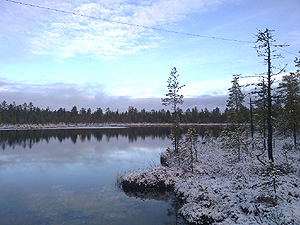
One of the beverage antennas
at Aihkiniemi (you can click on the photos in
this report to open larger images in a new browser
window) |
Convenience beat frugality, and
so we took the train instead of driving through
the night. Jim
joined me at the Helsinki railway station, and we
packed his stuff in my Nissan Murano for the ride
north. Our cabin even had a private shower, which
we learned to appreciate as there wouldn't be one
in Aihkiniemi.
We woke up early on Saturday, October 16, when the
train arrived in Rovaniemi on the Arctic Circle,
to continue the journey driving further north. The
weather was far from Arctic, but it was set to change
dramatically over the week. We ran into reindeer
several times, but fortunately didn't run over any.
This DXpedition entailed more
uncertainty than normally, as Aihkiniemi was still
somewhat a work in progress. I and Jim are among
a group of eight DXers who purchased a lakeside
lot in northernmost Lapland earlier this year to
set up the first ever purpose-built AM DXing base
in Finland, if not the first such endeavour in Europe
or the World.
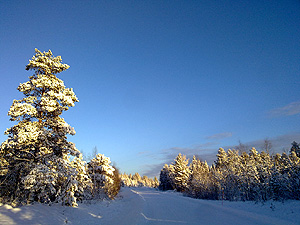
The road between Kaamanen
and Sevettijärvi, close to Aihkiniemi |
DXer Martti Karimies successfully
ran the project and got things moving fast. Just
a few months from the land deal and building permit
we already had a working DX base.
Aihkiniemi is located at 69.23
degrees North and 27.87 degrees East, essentially
in the middle of nowhere, so we got to christen
the place. According to title records, the original
larger property had been called Aihkiniemi, so we
resurrected that name to refer to this new DXing
haven. "Aihki" means a grand, ancient
pine tree, specifically in Lapland, and "niemi"
translates as a cape or a peninsula. Sure enough,
there are impressive old growth pines in the area,
and the landscape is dotted with tiny lakes and
rivers carving a very varied terrain, and one that
is sometimes very difficult to cut across.
Our group had bought, refurbished,
and transported a container-shaped cabin from a
construction company, and in August we had built
eight beverage antennas, each close to 1 kilometer
(over 3000 ft) in length. I and Jim erected the
ninth antenna, pointing at 30 degrees, which brought
us the Southern Pacific goodies. At least one more
similar size antenna will be built by later DXpedition
crews.

Jim at Aihkiniemi cabin
after the first snow |
The 30-square-meter cabin is
very basic and looks spartan, but it is well-equipped
for two DXers. There is a bedroom for two, an indoor
composting toilet, and a listening room with a kitchenette.
The toilet is real hi-tech, odorless and cost more
than the cabin itself! Our lot sits right next to
a paved road that leads to Norway, so having a driveway
built and getting electricity didn't cost a huge
fortune.
On arrival we were a bit confused
about the workings of the antennas, and couldn't
get a decent signal out of an amplifier that we
used in the cottage, so Saturday night and Sunday
were spent on trying to fix things. We built the
30-degree antenna over swampy ground, and worked
on the baluns, Jim being the seasoned expert and
me the clueless disciple. Eventually getting a good
enough signal from nearly all the antennas.
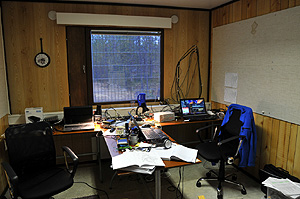
The DX central of Aihkiniemi |
Aihkiniemi turned out to be relatively
free of interference. Our own AC adaptors were the
biggest source of unwanted sounds on the AM dial,
although we tried to exclude the noisiest adaptors
already in advance. Fluorescent lights in the cabin
had to be turned off during the daytime, and will
need to be replaced in the future. A nearby power
line with ADSL signals might have caused some faint
interference, but we were unable to verify the source.
In the future, once everything is running smoothly,
we intend to make this base available for other
DXers as well.
As receivers we relied solely
on the Perseus, which should guarantee enough recordings
to entertain us for the rest of our lives. Detailed
log listings will be published at some point in
the distant future because of the overwhelming workload
of checking the files.
Jim's stay in Aihkiniemi was
unfortunately interrupted by work obligations, and
already on Monday I drove him to the Ivalo airport
for a flight south, but I continued making recordings
on his behalf as well.

A shared bedroom —
better make sure that your partner doesn't snore! |
This was the third DXpedition
to Aihkiniemi. The beginning is always tough in
a new place, and the first two crews spent even
more time on construction and problem solving. Most
likely upcoming DXpeditions will produce even more
impressive logs than ours, but this week was enough
to convince me that we've found a real gem for AM
DXers.
Once I had overcome most technical
hurdles, it was time for some serious DX. On most
mornings I got very good reception from various
parts of the Western Hemisphere around 0430-0600
UTC. On a few days stations from the Pacific Northwest
remained on the dial through the day, but generally
daytime conditions didn't amount to much, and nighttime
conditions were very poor. In late afternoons, conditions
to China were excellent almost every day. Occasionally
I also got nice reception of Korean and Japanese
stations, areas which tend to be more productive
in terms of new catches. The more southern antennas
towards the Eastern Hemisphere continued to have
problems, so I missed lower latitudes in Asia.
The highlight of the DXpedition
was Thursday, October 21, when conditions to all
directions seemed very good. After a nice morning
I picked up Newstalk ZB, the first New Zealand AM
station of my life, at 1108 UTC on 1035 kHz. I identified
a couple of other Kiwis as well in real time, including
Southern Star on 657 kHz at 1207 UTC, when a local
pest in Murmansk on the same frequency luckily happened
to be off the air for some reason. What an unforgettable
afternoon!
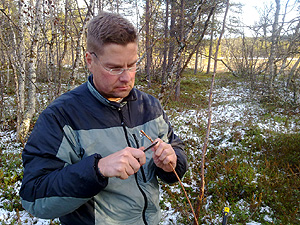
Jim preparing grounding
at the 30-degree antenna |
To put things into perspective,
I have been actively hunting for Kiwi AM stations
for over a decade without catching any. Now I heard
a bunch of them after only four days of monitoring
with the new 30-degree antenna in Aihkiniemi. This
opening seemed remarkable to me, although according
to our Norwegian DX friends in Kongsfjord (see the
KONG20
DXpedition blog) it was really not that exceptional
compared to the previous couple of weeks. So, even
better days can be expected. Lemmenjoki offered
another point of comparison, because a few NZ stations
were noted at the same time there as well, but much
weaker. Based on all this, it would be safe to say
that Aihkiniemi is currently the best place in Finland
for DXing New Zealand, and by extension, probably
other targets in the Southern Pacific as well. By
the time I am writing this, Jim and I have discovered
16 Kiwi stations, and quite a few promising frequencies
remain to be checked.

Mika checking the direction
while carrying the cable reel of the 30 degree
antenna |
Another true highlight was picking
up a 10-watt highway advisory station from Prudhoe
Bay, Alaska, on October 20. WQLE259 caught my attention
with its weather forecast loop running on 1610 kHz
and audible for over an hour. The identity of this
fairly new station remained a mystery, as the station
ID was far from clear. Based on the conditions at
the time, I initially suspected the Pacific Northwest,
but low temperatures pointed to Alaska, as Jim quickly
found out. West Coast DXers Bruce Portzer, Chuck
Hutton, and Patrick Martin came to the rescue and
nailed down the identitity of the station. After
a restless week I got my first TIS/HAR station verified.
In addition to the previously
mentioned KONG20 in Norway, there were other more
or less simultaneous DXpeditions in the Arctic regions
of Scandinavia: LEM294
in Lemmenjoki in Finland, PAX78
in Parkalompolo in Sweden and AND6
in Andøya, Norway.
Weatherwise the week was a rollercoaster
ride back and forth between the fall and the winter.
On the first day the small lakes were freezing,
next morning they were solid frozen, and again free
of ice by the following. On Saturday, October 23,
heavy snowfall made navigating on the roads really
hazardous, even with a four-wheel drive SUV. Winter
had arrived, a bit earlier than usually.

Not the best of my photos,
I admit, but still, three moose in the same
frame |
In addition to DXing, Lapland
never ceases to impress with its untouched nature.
Some of the encounters can be unpleasant, such as
trying to negotiate a path on a swamp where bogholes
are covered by snow but remain unfrozen and treacherous.
Also, on the roadside, for the first time I encountered
three moose at the same time. A collision with just
one would be enough to wreck the car and cause serious
injury, even death. Better slow down on the northern
roads. Reindeer, which are much more ubiquitous,
are not nearly as risky, as they have shorter legs
and don't tend to penetrate your windshield on impact.
As I mentioned, there is no shower
— nor running water for any other purpose.
It meant huge savings in construction, but we paid
a price. After a sweaty day working on the antennas
we had to drive 14 kilometers to take a shower and
haul drinking water from a rental cottage further
north. Oh well, a minor inconvenience in the scheme
of things. And of course, brave(r) DXers could take
a dip in the freezing lake on our own property,
although the water is so shallow that it isn't really
suited for swimming.
In the following you can find
a detailed description of the solar weather during
the week (thanks to Jan Alvestad), followed by a
detailed review of reception conditions on each
day.
| Date |
Mea-
sured
solar flux |
Sunspot
number |
Planetary
A index |
K
indices (3-hour intervals) |
Min-max
solar
wind speed (km/sec) |
Number
of flares (events) |
ST
AR |
NO
AA |
ST
AR |
NO
AA |
Daily low - high |
Planetary |
Boulder |
C |
M |
X |
| 15.10.2010 |
82.2 |
49 |
51 |
5.3 |
5 |
2-15 |
01011131 |
11121211 |
285-326 |
|
|
|
| 16.10.2010 |
86.9 |
68 |
48 |
5.9 |
6 |
0-15 |
12101132 |
12202222 |
300-343 |
|
1 |
|
| 17.10.2010 |
83.6 |
64 |
61 |
11.1 |
11 |
2-27 |
23431023 |
23532122 |
315-411 |
2 |
|
|
| 18.10.2010 |
90.6 |
99 |
58 |
5.1 |
5 |
2-15 |
20011123 |
21121113 |
326-381 |
3 |
|
|
| 19.10.2010 |
86.6 |
63 |
65 |
5.3 |
5 |
0-9 |
22211002 |
23222111 |
346-455 |
2 |
|
|
| 20.10.2010 |
83.9 |
35 |
61 |
3.8 |
4 |
0-9 |
20012011 |
21112011 |
368-430 |
1 |
|
|
| 21.10.2010 |
83.5 |
34 |
34 |
3.1 |
3 |
0-6 |
10002111 |
10102211 |
338-401 |
|
|
|
| 22.10.2010 |
81.4 |
52 |
34 |
6.1 |
6 |
2-18 |
01211223 |
11311234 |
345-532 |
|
|
|
| 23.10.2010 |
84.3 |
54 |
43 |
23.1 |
23 |
7-48 |
32445424 |
42444424 |
479-686 |
|
|
|
| 24.10.2010 |
85.0 |
42 |
34 |
1.4 |
1 |
0-4 |
10000010 |
10001110 |
271-277 |
1 |
|
|
Saturday, October 16, 2010
We arrived late in the afternoon,
only to start working on the antennas and sorting
out other technical problems, so that we didn't
really have much time to observe the dial. Huge
signals from Alaskan stations were noted, and even
Hawaiians were heard, although we didn't even have
an antenna pointed there. We got our recordings
rolling barely before 1600 UTC, but it was already
a bit too late for any interesting catches.

Mika tasting "Coke
Mika" — a French gift to the world |
Sunday, October 17, 2010
After a poor night, propagation
of North American stations began to improve before
dawn, around 0330 UTC. Reception peaked at 0430-0530
UTC and focused on the Midwest and the Rockies,
with some Mexicans in the mix. We identified for
instance KASL Newcastle WY on 1240 kHz and KTOQ
Rapid City SD on 1340 kHz. All daylight hours were
spent building and fixing antennas, but we arrived
back to the base early enough to catch a very good
opening to the Far East around 1500-1600 UTC. We
were able to identify for example many KBS stations
and AFN from Korea on 1080 kHz, JOLC Tottori from
Japan on 1125 kHz and Kungchuling PBS from China
on 1485 kHz. Earlier in the afternoon, a bunch of
Aussie goodies were logged in Kongsfjord, Norway,
but we missed them, once again.
Monday, October 18, 2010
A few weak Brazilians emerged
around 2130 UTC, but basically overnight there were
no trans-Atlantic stations to listen to. In the
morning U.S. stations became audible around 0430
UTC. Our sunrise turned out to be a decent opening,
0500 UTC being the best top-of-the-hour, and by
0600 the stations had weakened considerably. Initially
reception was best from the Midwest and the Rockies
(including stations such as 1230 KYSM Mankato MN
and 1570 KVTK Vermillion SD 1570 kHz). A bit later
also East Coast stations were heard. Although North
Americans vanished rather completely by 0700 UTC,
the Rockies and the West Coast emerged again just
before 0900 UTC, with such typical graveyard stations
as 1340 KLOO Corvallis OR and 1400 KART Jerome ID.
Around 1000 UTC some more Oregonians were heard,
including 550 KOAC Corvallis, 960 KLAD Klamath Falls
and 1240 KQIK Lakeview, as well as other stations
from the Pacific Northwest, including 1400 KQMS
Redding CA. In the afternoon, Asian stations were
in full swing by 1400 UTC. Stations were heard from
a wider area than before, from Japan to Thailand,
so finding new ones is much more difficult than
during the previous day. Also for example Hot Country
on 1628.958 kHz from Australia made it here with
a station ID.
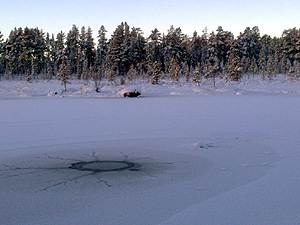
Jim, where did you go
— I can't see you anymore? |
Tuesday, October 19, 2010
Nighttime was again poor, and
the first North American stations appeared only
after 2300 UTC. Although weak signals continued
to be heard through the night, I doubt that my recordings
would reveal anything interesting. In the morning
around 0500 UTC just as I expected signals to gain
strength, nearly all North American stations vanished,
leaving just a couple of weak Albertans on the dial.
Simultaneously, a handful of Brazilian stations
became audible for a while. Spanish and other West
European stations were exceptionally strong, so
that I was finally able to catch the elusive COPE
Murcia on 711 kHz and a couple of RNE stations during
regional breaks. Stations west of the Rockies reappeared
after 0800 UTC, but were generally very weak until
improving just before 0900 UTC, in repetition of
the day before. Today, however, the Pacific Northwest
remained on the dial late, until around 1400 UTC.
The first Asian signals rose above the noise floor
briefly around 1140 UTC, but reappeared only after
a lull of three hours, when it was already getting
dark outside. The Asian mix quickly gave way to
Iranians and Europeans. Weak X-band Aussies were
heard around 1530 UTC, slightly later than on the
previous day. Some of the most common Hawaiians
appeared around 1230 UTC, and KUAU Haiku on 1570
kHz was booming like a semi-local, although I didn't
even have an antenna pointing straight north.

The sun does rise, but
barely above the horizon |
Wednesday, October 20, 2010
The first North American stations
emerged already before 2100 UTC on Tuesday evening,
and the first Brazilians a bit later, but signals
remained sporadic and very weak. Brazil and Argentina
were somewhat better in the morning after 0500 UTC.
After 0400 UTC the Pacific Northwest gave the best
reception of any trans-Atlantic area, and Mexicans
showed up around 0500 UTC. Latin American stations
gave a wild ride this morning, suddenly vanishing
and soon appearing again, with a couple of Caribbean
powerhouses heard even after 0630 UTC. As is customary,
the Pacific Northwest, Alberta, and Alaska were
heard more or less through the daylight hours, with
improved signal levels after 1000 UTC. Trans-Atlantic
stations vanished after 1200 UTC. Among the Northwest
highlights are KLDY Lacey WA on 1280 kHz and KXRO
Aberdeen WA on 1320 kHz — and of course WQLE259
on 1610 kHz, although it took several days to find
out what it was all about. Apart from serious DXing,
it was fun to listen to for example KHAR Anchorage
AK on 590 kHz at armchair level. In the afternoon
Asian stations popped up earlier than before on
this DXpedition; the first signals were audible
already at 1100 UTC. China, Japan and Korea dominated
the dial, but also a few Philippine stations were
noted after 1300 UTC, a first during this DXpedition.
Signal levels were impressive, but it will be challenging
to extract anything new from such a wide-angle Asian
deluge. KCBS Chongjin on 702.041 kHz and HLKH KBS
Gwangju on 747 kHz are among today's highlights.
Thursday, October 21, 2010
Both North and South American
stations were heard through the night with relatively
weak signals. Stations from Brazil and Argentina
peaked remarkably late, after sunrise at 0600-0645
UTC, which was convenient, as strong European interference
had already begun to subside. Especially UK stations
were exceptionally strong this morning, beating
Spanish stations on the same frequencies. North
American stations remained on the dial after sunrise,
which was a welcome change to the routine of the
previous days, and only the very low end of the
AM band pretty much sank into the static. Another
welcome change was that the best propagation didn't
immediately move on to the Pacific Northwest, but
stayed in the Great Lakes area instead, with also
many East Coast stations going strong. Cubans peaked
around 0700 UTC. Overall, this was a very good morning
compared to the previous ones on this DXpedition,
but rather ordinary compared to average October
propagation conditions. Mexicans and graveyard channels
improved after 1000 UTC as conditions began to shift
westwards.
DXing
on the air on Newstalk ZB
I eventually heard Newstalk ZB on six
different frequencies (1008, 1026, 1035,
1080, 1215, 1296 kHz) fading in and out,
over a period of more than an hour. On
the air was overnight host Nick Robinson.
I emailed him, and got back a nice verification.
Later Nick also shared my report with
his audience; you can hear the first
and second
clip here. The first clip contains one
of the recorded IDs that I sent; it was
clear enough that Nick was able to play
it on the radio for his local audience. |
|
Then, the afternoon was a fulfillment
of a longtime dream: my first New Zealand AM stations.
The new 30-degree antenna works like a super vacuum
cleaner. One of the long-sought stations was Southern
Star, Wellington, on 657 kHz just as Murmansk across
the border had turned its transmitter off for some
reason — it was back on the air later the same
afternoon. I also became acquainted with the Newstalk
ZB format. I sort of anticipated goodies from Down
Under, so I had some Rawson's Retreat Shiraz Cabernet
from Australia at hand to celebrate the milestone
— the Inari wine shop didn't stock Kiwi red
wines. Superb conditions to the Eastern Hemisphere
continued with an overdose of Japanese and Chinese
stations.
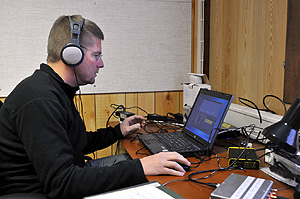
Jim listening with a Perseus
and a laptop |
Friday, October 22, 2010
Nighttime conditions were better
than before this week, both to North and South America,
where also the upper half of South America was represented
— hardly heard before. Before daybreak, the
focus was in the Rockies, from Alberta to Baja California,
but also Spanish stations were booming. Signal levels
subsided and the lower end of the AM band mostly
vanished after sunrise, but Westerly conditions
continued. North American stations vanished by 0830
UTC, but emerged briefly again just before 1000
UTC. The afternoon was poor, only weak stations
from the Pacific Northwest. Asians arrived late,
around 1300 UTC, and were under heavy European interference.
Eventually conditions to Asia turned out to be not
totally hopeless, but spread over a wide area from
Japan to Iran — and not having a proper antenna
pointed at South Asia hampered efforts to find something
new.
Saturday, October 23, 2010
Overnight conditions to Brazil
seemed decent at times, and also U.S. stations were
heard during the wee hours, but at dismal levels.
At daybreak signal levels on the entire AM band
collapsed, and the morning seemed a total loss until
there was an opening to the Caribbean around 0515-0600
UTC, with Radio Comercial from the Dominican Republic
on 1010 kHz being the highlight. Spanish stations
were booming, which was expected, as this was a
Saturday with very limited chances of catching local
or even regional station identifications. After
0600 UTC only European powerhouses were left on
the AM band, so it was painless to pack up everything,
and head to Lemmenjoki
for another week of DXing.
Published
on November 9, 2010, slightly edited later
  
|